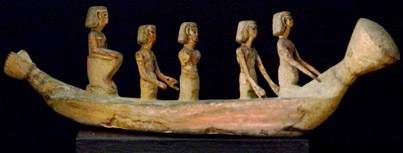
Egyptian model boat, 2000 BCE. Placed in tombs to provide transport in the afterlife.
Claudio Calligaris
New gallery for old artefacts
The 19th-century Redpath Museum has a new space to be proud of. The Ethnology Gallery has finally opened up on the third floor after two-and-a-half years of renovation and preparation.
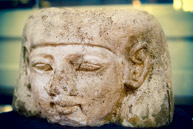
Egyptian limestone portrait head, 1200 BCE, from New Kingdom's 19th Dynasty. The headdress indicates it's of a non-royal male; the head probably served an architectural function.
Claudio Calligaris
Brand new display cases, specially designed for the museum, now house hundreds of artefacts from around the world, spanning thousands of years, that tell us about the cultural beliefs and social relationships of humanity.
Although the collection is rich, previously only a small portion of it has been on view for the public during the Museum's 122-year history. (In Principal Dawson's time, these objects were known as the "Archaeological and Miscellaneous Collections"). Now Redpath's famous Egyptian mummies — three human and five animal — share the floor with Sri Lankan materia medica and Ayurvedic medicinal treatments for blindness; tiny terracotta figurine heads from the ancient Mexican city Teotihuacán; a Samurai warrior's suit of armour; and a Peruvian shrunken head (determined to be that of a monkey, thanks to DNA analysis done by Michel Tremblay, director of McGill's Cancer Centre, and his research team). Curator Barbara Lawson was delighted to see the bright and attractive results of all the hard work of the students and volunteers who helped put the gallery together. The gallery was feted at a well-attended inauguration on December 3.
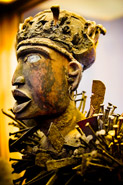
Mid-19th-century Angola figure (from near Congo). Not itself magical, but made so by a diviner who pierced it with nails and placed magical substances into its abdominal cavity.
Claudio Calligaris
Lawson and her team worked on everything from selecting the objects from a pool of 17,000, to designing exhibits, to researching and writing the information labels. "There has to be a narrative structure to the displays," she said.
After all, nifty-looking things can't just be thrown up without rhyme or reason. A betel nut spatula from the Trobriand Islands in Papua New Guinea only evokes a modicum of interest without an explanation as to betel's social and ritual use. And a Lwena mask from Angola (circa 1930) with elaborate vegetable-fibre hair is juxtaposed with 19th-century hair combs and '80s and '90s advertisements from Ghana depicting modern African hairstyles as influenced by African-American popular culture.
Many of the objects have belonged to McGill for ages. The Theban mummies were brought here from Egypt in 1859 (a dramatic CT scan done in 1995 — also on display — revealed one to be of a 30- to 35-year-old male). Kongo power figures arrived at our colder climes in the 1860s.
Donations have always played an important role in university museums, and the Redpath is no exception. Recently, Mary Salisbury and her children donated objects from her late husband, former dean of arts Richard Salisbury, one of the founders of the anthropology department, from his fieldwork in Papua New Guinea. Lawson herself donated a recently made Mother Hubbard dress — or ilan dres — from the island of Erromango in Vanuatu in the South Pacific.
One of the loveliest innovations in the display is also one of the simplest. Stone in its natural form is placed alongside Ancient Egyptian pots and bowls carved out of that very material. "It's easy to forget how much work goes into creating these," Lawson says. The juxtaposition sparks a sudden understanding that is rare, but essential for an educational museum.
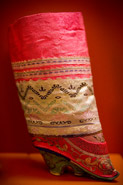 Late 19th-century—early 20th-century Chinese lotus slippers, Cantonese style (fibre, skin, metal), to be worn by women who'd had their feet bound. |
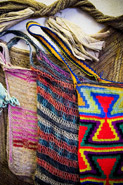 Net bags from Papua New Guinea, 1952—1984. Early bags made of wild fig bark took up to three days to make. They were a form of a woman's wealth. |
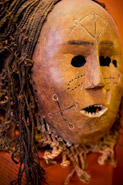 Lwena pwevo mask from Angola, circa 1930 (wood, pigment, vegetable fibre, and metal). Symbolizes fertility and represented the ideal woman in male initiation ceremonies. |
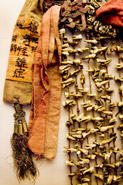 19th-century Chinese dentistry banner, made of teeth, hung up to advertise a tooth extractor's services. |
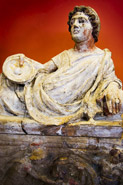 Etruscan funerary urn, second-century BCE. Figure of a wealthy man reclining as though at a banquet, holding a libation dish. |
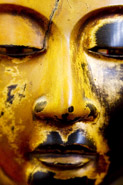 Japanese Buddha Amida Nyorai (Buddha of the Western Land of Paradise), typical of the era from 794 to 1192. Made in the 18th—19th century (wood and gilded lacquer). |
